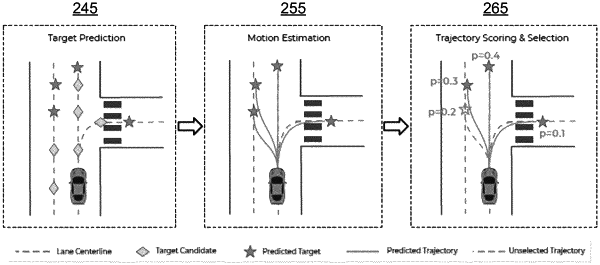| CPC B60W 60/001 (2020.02) [G06N 3/02 (2013.01); B60W 2420/42 (2013.01); B60W 2554/4049 (2020.02)] | 18 Claims |

|
1. A method performed by one or more computers, the method comprising:
obtaining scene context data characterizing an environment, the scene context data comprising data that characterizes a trajectory of an agent in a vicinity of a vehicle in an environment up to a current time point;
identifying a plurality of initial target locations in the environment;
generating, for each of a plurality of target locations that each corresponds to one of the initial target locations, (i) a respective predicted coordinate offset between the target location and the corresponding initial target location and (ii) a respective predicted likelihood score that represents a likelihood that the target location will be an intended final location for a future trajectory of the agent starting from the current time point;
selecting a first subset of the target locations based on the respective predicted likelihood scores of the target locations;
for each target location in the first subset of the target locations, generating a predicted future trajectory for the agent that is a prediction of the future trajectory of the agent given that the target location is the intended final location for the future trajectory;
selecting, as likely future trajectories of the agent starting from the current time point, one or more of the predicted future trajectories; and
controlling the vehicle using the one or more selected predicted future trajectories.
|